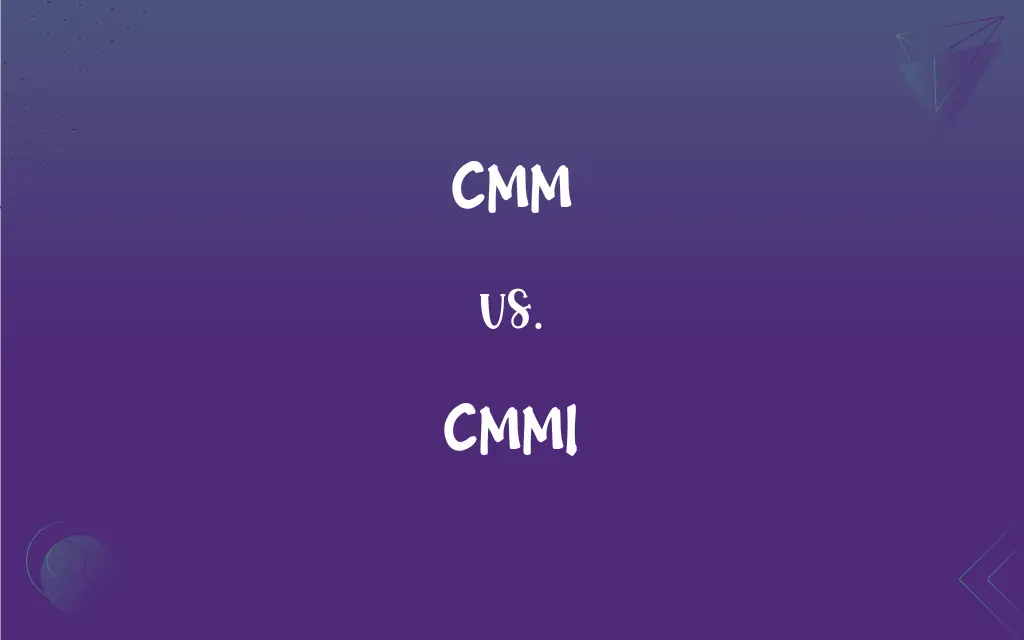CMM vs. CMMI: What's the Difference?
Edited by Aimie Carlson || By Harlon Moss || Published on September 13, 2024
CMM (Capability Maturity Model) assesses software development processes; CMMI (Capability Maturity Model Integration) extends this to other areas, integrating multiple models.

Key Differences
CMM, standing for Capability Maturity Model, is primarily focused on improving software development processes. It's a structured framework that helps organizations in developing effective software processes. In contrast, CMMI, or Capability Maturity Model Integration, takes a more holistic approach. It not only addresses software development but also integrates various aspects of business operations, extending the principles of CMM to broader areas.
The CMM framework is older and was initially developed by the Software Engineering Institute in the 1980s. It emphasizes on the software development lifecycle, aiming to elevate the quality and efficiency of software processes. CMMI, however, is a more recent development. It not only encompasses software development but also factors in other business processes, offering a more comprehensive improvement model.
CMM is structured into five maturity levels, each indicating a higher level of process maturity. These levels help organizations in assessing their current process capabilities. CMMI, while also having maturity levels, provides a more integrated approach. It combines best practices from various domains, offering a more versatile framework applicable across different business areas.
In terms of application, CMM is mostly used within the context of software engineering. It serves as a guide for software organizations to improve their development processes. On the other hand, CMMI finds application in a variety of fields including software engineering, systems engineering, and project management, making it a more versatile model.
CMM primarily deals with the maturity of processes in software development. It's a tool for organizations to measure and improve their software process efficiency. CMMI, in contrast, goes beyond just process improvement. It integrates multiple models and focuses on enhancing organizational capabilities in a broader context, including areas such as product lifecycle management and service delivery.
ADVERTISEMENT
Comparison Chart
Focus
Software development processes
Integration of multiple business processes
Origin
Developed in the 1980s
Evolved from CMM, includes newer practices
Maturity Levels
5 Levels
5 Levels with integrated approach
Application
Specific to software engineering
Broad, including software, systems engineering, etc.
Goal
Process maturity in software development
Organizational capability enhancement
ADVERTISEMENT
CMM and CMMI Definitions
CMM
CMM is a framework for evaluating and improving software development processes.
The company adopted CMM to enhance its software development quality.
CMMI
CMMI integrates various models to enhance overall organizational efficiency.
Through CMMI, we achieved a more cohesive and efficient operational framework.
CMM
CMM categorizes software process maturity into five distinct levels.
Our organization reached Level 3 of the CMM, indicating improved process standardization.
CMMI
CMMI is an integrated model for improving overall business processes.
The company implemented CMMI to optimize its project management processes.
CMM
CMM serves as a guide for software organizations to elevate process efficiency.
The CMM framework guided our team in streamlining the software production cycle.
CMMI
CMMI extends CMM by incorporating additional business practices.
CMMI enabled us to integrate best practices in both software and systems engineering.
CMM
CMM focuses on identifying and replicating successful practices in software development.
Using CMM, they could identify key processes that needed refinement.
CMMI
CMMI focuses on elevating organizational capabilities across multiple domains.
Adopting CMMI significantly improved our cross-departmental process alignment.
CMM
CMM assesses and aids in the development of structured software processes.
Implementing CMM helped in systematically improving our software delivery.
CMMI
CMMI provides a structured approach to process improvement beyond software.
CMMI's comprehensive model helped in refining our service delivery strategies.
CMM
Abbreviation of cubic millimetre
FAQs
How is CMMI different from CMM?
CMMI integrates multiple business process models, extending beyond software development.
Can CMMI be used for project management?
Yes, CMMI includes best practices for project management.
Can CMM be applied to non-software processes?
CMM is specifically tailored for software development processes.
Is CMMI applicable to small organizations?
Yes, CMMI can be adapted to organizations of all sizes, including small businesses.
Does CMMI replace CMM?
CMMI builds upon and extends CMM, integrating additional business practices.
Is training required to implement CMM?
Yes, proper understanding and training are necessary for effective CMM implementation.
Can CMMI be customized for specific industries?
CMMI is versatile and can be adapted to various industry needs.
What is the first level of CMM?
The first level of CMM is the "Initial" level, indicating ad hoc and chaotic processes.
What is CMM?
CMM is a model designed to improve and assess the software development process.
What are the maturity levels in CMM?
CMM has five maturity levels, each indicating a higher degree of process refinement.
How does CMM improve software processes?
CMM provides a structured framework for assessing and enhancing software development practices.
Does CMMI focus only on software development?
No, CMMI covers a broad range of business processes, not just software development.
Are there different versions of CMM?
Yes, CMM has evolved over time with several updated versions.
How long does it take to implement CMM?
Implementation time varies based on organizational size and complexity.
How often should CMMI assessments be conducted?
Regular assessments are recommended to ensure continuous improvement.
Is there a certification for CMMI?
Yes, organizations can achieve different levels of CMMI certification.
What is the highest level in CMM?
The highest level in CMM is Level 5, "Optimizing."
How does CMMI benefit an organization?
CMMI enhances overall organizational capabilities and process efficiency.
Can CMMI be integrated with other quality standards?
Yes, CMMI can be aligned with other quality and management standards.
Is CMM still relevant?
While still valuable, CMM has largely been superseded by CMMI and other frameworks.
About Author
Written by
Harlon MossHarlon is a seasoned quality moderator and accomplished content writer for Difference Wiki. An alumnus of the prestigious University of California, he earned his degree in Computer Science. Leveraging his academic background, Harlon brings a meticulous and informed perspective to his work, ensuring content accuracy and excellence.
Edited by
Aimie CarlsonAimie Carlson, holding a master's degree in English literature, is a fervent English language enthusiast. She lends her writing talents to Difference Wiki, a prominent website that specializes in comparisons, offering readers insightful analyses that both captivate and inform.






































































